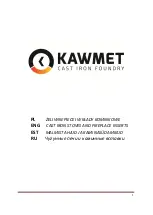
OM-PE E V1.08
August 24, 2015
Page 30
PE1006
CATALYST MONITORING
CATALYTIC COMBUSTOR, CLEANING
Under certain conditions, ash particles may become attached to the face of the combustor. Th
ese may be seen while the
combustor is in the glowing stage, or when the fi re is out. Any deposit on the visible face of the combustor should be
removed. Wait until the fi re is out and the stove is cold before performing any cleaning. Brushing the combustor with a
soft bristle paint brush will remove some deposits. Passing a vacuum cleaner wand or brush near the face of the combustor
will remove most deposits. (Hot ash in a vacuum cleaner bag will burn, may melt the vacuum or cause a house fi re.
Exercise caution and never clean the stove when the stove or ashes are hot.) Never scrape the combustor with any hard
tool or brush. Never run pipe cleaner through the individual cells of the combustor. Th
is is not needed, and may do more
harm than good. Limit cleaning to the face of the combustor.
NOTE: Never remove a combustor without approved
combustor gasket in hand as original gasket will fall apart when removed from stove
. Remember to re-install the Flame
Shield (the perforated plate) in same position it was found.
TIP: A hot fi re will usually prove to be the best method of cleaning the combustor of deposits.
CATALYTIC COMBUSTOR, TESTING
Light the fi re as per the lighting instructions (see LIGHTING THE FIRE on page 26). Th
en set the thermostat knob on a
MED setting. When the fi re is well established (within one to three hours) turn the thermostat knob between
LOW
and
MED
. A properly operating combustor will remain active, and the combustor thermometer will remain in the “active”
zone until the wood load is mostly consumed. A “tired” or “dead” combustor will, with the thermostat on
MED
or lower,
go out completely, and the thermometer needle will fall into the “inactive” zone. Repeat this procedure several times over
several days (Remember that the combustor thermometer has a built-in lag of 4-8 minutes.) If, aft er several test burns,
the thermometer will not indicate an “active” combustor, it may require cleaning or replacement. It is also possible that
the thermometer, itself, may not be reading accurately. Before condemning the combustor, read “THERMOMETER”. If,
aft er cleaning has been performed, your combustor is still not working you can Contact Blaze King for a replacement
combustor. Please read “REPLACEMENT PARTS” section in this owners’ manual.
It is important to periodically monitor the operation of the catalytic combustor to ensure that it is functioning
properly. A non-functioning combustor will result in a loss of heating effi
ciency, and an increase in creosote and
emissions. Following is a list of items that should be checked on a periodic basis:
•
Combustors should be visually inspected at least three times during the heating season to determine if physical
degradation has occurred. Actual removal of the combustor is not recommended unless more detailed inspection is
warranted because of decreased performance. Refer to “CATALYTIC COMBUSTOR TROUBLESHOOTING” on next
page.
• Th
is catalytic heater is equipped with a temperature probe to monitor catalyst operation. Properly functioning
combustors typically maintain temperatures in excess of 500°F (indicated by the thermometer needle in the active
zone), and oft en reach temperatures in excess of 1000°F. If catalyst temperatures fall below 500°F (indicated by the
thermometer needle in the inactive zone), refer to next step and to “CATALYTIC COMBUSTOR, TESTING” below.
•
You can get an indication of whether the catalyst is working by comparing the amount of smoke leaving the chimney
when the smoke is going through the combustor and catalyst light-off has been achieved, to the amount of smoke
leaving the chimney when smoke is not routed through the combustor (bypass mode):
-
Light the stove as per the lighting instructions “LIGHTING THE FIRE”. With smoke routed through the catalyst,
go outside and observe the emissions leaving the chimney.
-
Open the bypass mechanism, wait approximately 15 minutes, and again observe the emissions leaving the
chimney. Signifi cantly more smoke will be seen when the exhaust is not routed through the combustor (bypass mode).
Some smoke may be visible shortly aft er you start the fi re and shortly aft er reloading the fi re. Allow 20 to 30 minutes
for the fi re to stabilize before making observations.
Summary of Contents for KING KE1107
Page 49: ...OM PE E V1 08 August 24 2015 Page 49 PE1006 REPLACEMENT PARTS cont REPLACEMENT PARTS cont ...
Page 50: ...OM PE E V1 08 August 24 2015 Page 50 PE1006 REPLACEMENT PARTS cont ...
Page 57: ...OM PE E V1 08 August 24 2015 Page 57 PE1006 NOTES ...
Page 58: ...OM PE E V1 08 August 24 2015 Page 58 PE1006 NOTES ...
Page 59: ...OM PE E V1 08 August 24 2015 Page 59 PE1006 NOTES ...
















































